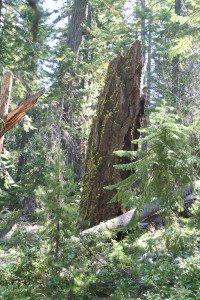Moss on the North Side of a Tree? This topic has started to pop up in my land navigation classes.
by Blake Miller
Recently, one of my wilderness survival students told me about a Ray Mears' video on YouTube called the "Path Finder." The student asked my my opinion of Mears' methods.
 |
| Moss on the west side of a stump! |
 |
| Click here to buy survival kit |
- By looking at the growth of tree limbs (larger limbs on the south side)
- Finding a cut tree stump and determining directions based on the growth rings
- Using the hour hand of a watch to determine direction, and;
- Using the sun, stick and shadow method to determine direction.
My survival class tested the tree limb theory on the campus of a college in the Willamette Valley of Oregon. Though there were several deciduous trees, most were fairly young and none convincingly pointed south.
Number two, I've got to find a tree stump to check that out. Still, if you are on a north facing slope will you get that clear direction determination?
So, in my region of the Northwest, method one and two are not working for me. In June. I was able to link up with a friend (who has a doctorate in Forestry.) His sense was that trying to depend on the growth rings of a tree was risky and depended on too many variables to be of use.
Methods three and four have been illustrated in books for years. Do they work? Sure.

But I'd ask you to consider just how accurate these methods are. Rather than a specific heading such as 180 degrees (that is south) you will get a trend of direction; as in you are heading in a southerly direction. That may be all you need.
It might be hard to test out method three with a digital watch.
For more information about methods three and four take a look at the following references:
- Staying Found by June Fleming, Chapter 7; Camping & Wilderness Survival by Paul Tawrell, start on page 175 ( As an aside, I have enjoyed the few Ray Mears' videos that I have seen. If you are looking for a good video on backcountry survival in winter watch his BBC documentary, the Real Hero's of Telemark. It's is outstanding. To watch "The Pathfinder" video go here.)
To read the SurvivalCommonSense post on determining directions by tree moss, click on myth busted.
Blake Miller has made a career out of staying found and knowing where he is at all times. His formal navigation training began when he joined the U.S. Navy in 1973. He served as an officer aboard several Navy ships over his twenty-year career; many of those tours included the duty of Navigator. Blake began working with satellite navigation systems at sea in 1976, culminating with the then-new Global Positioning Systems aboard the Battleship WISCONSIN in early 1990.
In 1998 Blake started Outdoor Quest, a business dedicated to backcountry navigation and wilderness survival. Blake has taught classes to wild land firefighters, state agency staffs, Search and Rescue team members, hunters, hikers, skiers, fishermen and equestrians. He regularly teaches classes through the Community Education programs at Central Oregon (Bend) and Chemeketa (Salem, OR) Community Colleges.
As a volunteer, Blake teaches navigation and survival classes, to students in the local school district and conservation groups. He is a member of a Search and Rescue team.
Contact Information :
Website: www.outdoorquest.biz;
Phone: 541 280 0573;
Email: outdrquest@aol.com